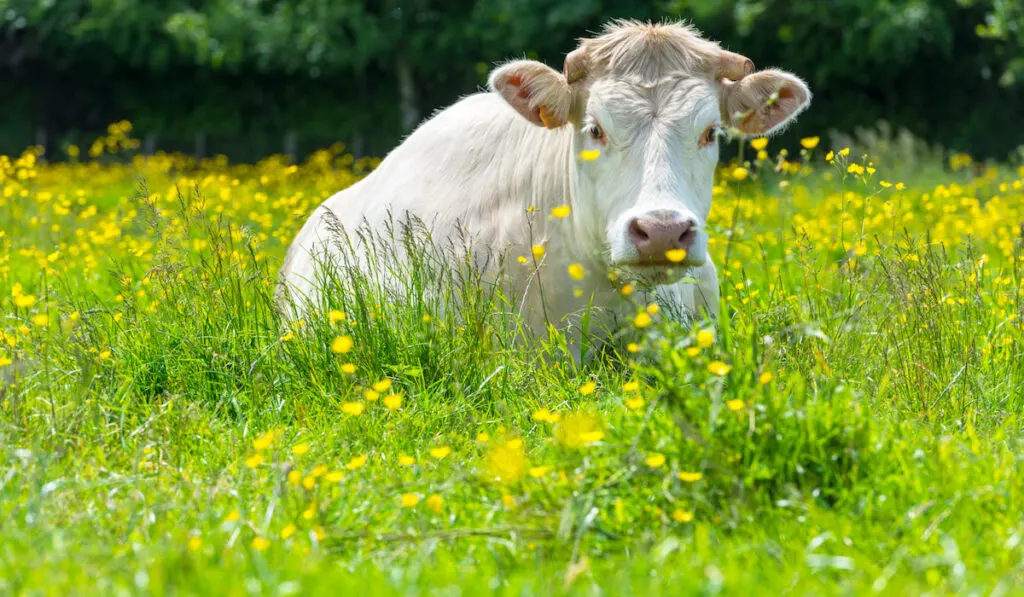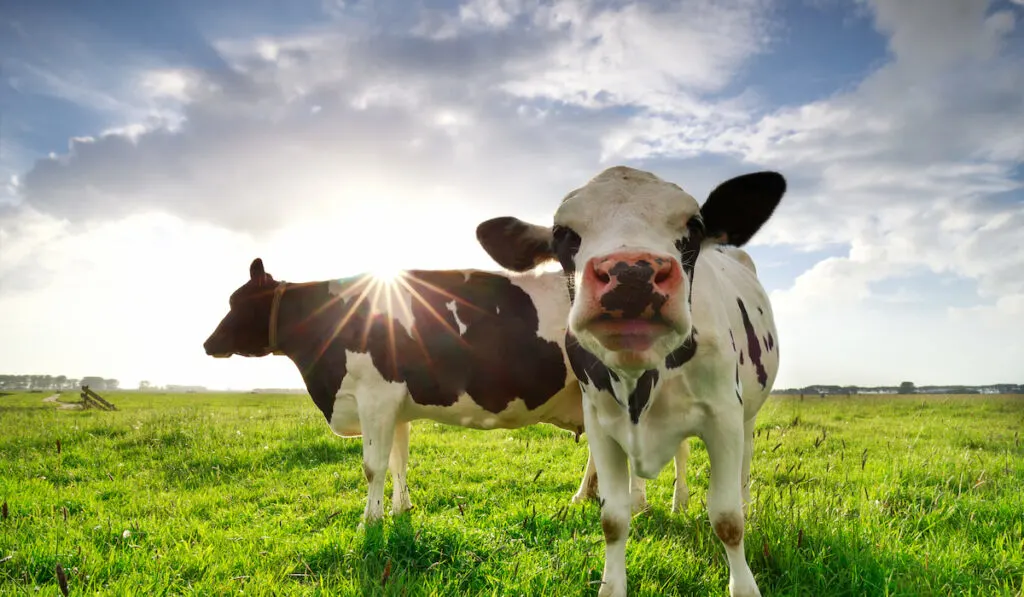If there’s one thing we are all familiar with after being outdoors for a while, it’s sunburn. Humans have the option of applying sunscreen before going outside as prevention, but what about animals?
You may have wondered at some point, do cows get sunburned?
Cows can get sunburned. Sunburn is a common phenomenon amongst animals with exposed skin. While a cow’s fur provides some degree of protection to its skin, this protection can be insufficient with prolonged exposure to the sun.

The possibility of cows getting sunburned is one reason why it is important to provide them with appropriate shelter, especially during extremely hot periods.
This article is aimed at guiding you on how to keep your animals cool during the heat to avoid sunburns. We will also take a look at the effects of sunburns and how to make proper shelters for your livestock.
Table of Contents
Do Cows Get Sunburned?
Like humans, cows get sunburned. Generally, susceptibility to sunburn is dependent on how much skin is exposed to the sun. You may find that since cows have relatively thick fur, sunburn is not as common as in humans.
So, what causes sunburn in cows?
A cow’s skin can withstand moderate exposure to the sun’s rays. But when exposed to the sun for extended periods, the skin absorbs way more ultraviolet (UV) rays than it can withstand. The excess UV rays cause DNA damage and trigger the symptoms of sunburn.

4 Tips for Cattle Shelter
Periods of high temperatures pose a serious problem for livestock. At such times, they find it hard to produce or grow, hence the importance of a good shelter.
When building your cattle shelter, consider the following tips to ensure heat is less of a problem for the cows:
- Your shelter should provide deep shade. Deep shade is defined as occurring when the ground of the shelter remains cool despite the temperature readings outside.
- The shelter should have proper ventilation, which ensures the circulation of air throughout the shelter. This helps to keep your livestock cool, and it also helps to control pests.
- The shelter should be big enough to accommodate water and food. Having water in the shelter at all times during hot weather is important. This allows the effective regulation of your livestock’s body temperature.
- You should ensure your livestock shelter is safe at all times. Make sure the structure is stable, and there are no places for your livestock to get stuck in. The shelter’s opening should be wide enough for multiple cows to pass through without getting injured.
7 Signs of Sunburn in Cows
Some signs of sunburn in cows include the following:
- Dairy cows may kick at cups during milking because of sensitive udder tissue
- The cows will be actively looking for shade to stand in
- Shaking of the ears and head
- There will be some swelling of any affected areas
- Irritation and blistering of the skin
- Skin necrosis and sloughing off
- Itchiness: cows may kick, scratch, or lick at the sunburned area.

5 Breeds of Cows More Prone to Sunburn
Just like humans, animals with lighter skin and coloring are more prone to sunburn than animals of darker colors. In truth, all cattle breeds are suscrptible to sunburn, but at varying degrees.
Sunburns are less likely to occur in cattle with pigmented skin or thicker furred breeds.
A casual study of Holstein cows showed that those with white coats suffer more sunburn than those with black coats. Also, those that had predominantly black coats suffered sunburn only around the white patches of hair.
Going by the above, the following cattle breeds may be more prone to sunburn:
- Charolais
- White Park Cattle
- British White Cattle
- White Vaynol Cattle
- Black and White Holstein (with a predominantly white coat)
Photosensitization in Cattle and Risks to the Skin
Photosensitization is a type of sunburn that occurs when ultraviolet light activates phototoxins present in cattle’s skin. It typically causes skin inflammation, and it tends to affect cattle with no skin pigment or those without hair.
Unlike sunburn, photosensitization doesn’t require prolonged exposure to sunlight.
When cattle eat plants, the chlorophyll breaks down to release the phototoxin called phylloerythrin. Phylloerythrin is normally broken down by a cow’s liver.
But when present in large quantities or when the liver is damaged, phylloerythrin accumulates in the blood.
Following accumulation in the blood and exposure to the sun, phylloerythrin causes photosensitization.
The damage from photosensitization causes the skin to die and slough away. This happens because photosensitization runs deeper than the usual sunburn. In some cases, photosensitization causes liver damage.

To treat photosensitivity, it is important for the affected animal to have access to shelter throughout the day. The shelter could be inside farm buildings or beneath trees.
Injections that would help reduce the irritation can be administered. The treatment would help reduce the itching and rubbing of infected areas. Changing to hay from green pastures also helps reduce the amount of chlorophyll they have to process.
Should You Put Sunblock on Cows?
With the dangers sunburn and photosensitivity pose to livestock, one important question that has been raised is the use of sunblock on cattle.
The application of sunblock on cattle is possible, but it should be done with advice from a veterinarian.
Emollient zinc sunblock creams can be applied to the sunburn area. It should be applied to the areas around the teat and udder to prevent them from scarring.
Your veterinarian may also recommend antibiotics to help treat skin lesions.
5 Ways to Protect Your Cows From Sunburn
The best way to treat sunburn in your cows is to prevent it from happening in the first place. Need tips? Follow these:
- Apply sunblock on the exposed parts of the cows before they go out to pasture.
- Reduce their prolonged exposure to intense sunlight.
- Try to eradicate the photodynamic plants in your pasture.
- Change the diet of the cattle and give them more hay instead of pasture.
- Spray them off with water, or install misting stations, especially inside their shelters.
Final Thoughts
Cows can get sunburned, and their sunburns can be very bad. While sunburns are treatable in cows, it is more beneficial if it never happens. Take the right steps to prevent your cows from getting sunburned.
Resources
- https://www.hobbyfarms.com/livestock-care-cattle-cows-sunburn/
- https://feastandfarm.com/keeping-animals-cool-livestock-shelter/
- https://www.thevetgroup.com.au/plant-toxins-and-photosensitivity-in-cattle/
- https://www.hpj.com/archives/livestock-susceptible-to-sunburn-too/article_5de01108-45f8-5b82-9777-9a51b9f9d5e9.html
- https://www.rte.ie/brainstorm/2018/0723/980486-hot-cows-a-summer-of-sunscreen-for-cattle/
- https://www.shelterlogic.ca/protecting-animals-from-the-summer-heat-and-sun/
- https://vetmed.illinois.edu/pet_column/protect-pastured-animals-photosensitization/
- https://www.smithsonianmag.com/science-nature/ask-an-expert-do-animals-get-sunburned-28218217/
